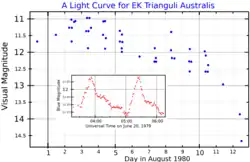EK Trianguli Australis
EK Trianguli Australis is a star in the constellation Triangulum Australe. It is a dwarf nova of the SU Ursae Majoris type that officially classified as such in 1980,[7] after the characteristic eruptions of a short eruption and a supereruption were observed in May 1978 and June 1979 respectively. These systems are characterised by frequent eruptions and less frequent supereruptions. The former are smooth, while the latter exhibit short "superhumps" of heightened activity.[8] The distance of the system has been assumed at 180 parsecs (586 light years) from the Solar System, for the donor star (assumed to be a red dwarf that is nondetectable at that range).[5] Spectroscopic analysis and calculation gave an estimate of 125 parsecs (407.5 light years).[9]
 A light curve for EK Trianguli Australis. The main plot, adapted from Hassall (1985),[1] shows the fading after an outburst. The inset plot, adapted from Vogt and Semeniuk (1980),[2] shows two superhumps. | |
| Observation data Epoch J2000 Equinox J2000 | |
|---|---|
| Constellation | Triangulum Australe |
| Right ascension | 15h 14m 01.46928s[3] |
| Declination | −65° 05′ 32.0604″[3] |
| Apparent magnitude (V) | 10.4 − 16.4[4] |
| Astrometry | |
| Distance | >586[5] ly (>180[5] pc) |
| Other designations | |
| Database references | |
| SIMBAD | data |
The system consists of a white dwarf and a donor star which orbit around a common centre of gravity every 1.5 hours.[10] The white dwarf sucks matter from the other star onto an accretion disc and periodically erupts, reaching apparent magnitude 11.2 in superoutbursts, 12.1 in normal outbursts and remaining at magnitude 16.7 when quiet.[11] The "superhumps" see the star increase by 0.24 magnitude for 1.55 hours during these superoutbursts.[8]
Spectroscopic observations of the white dwarf with the Hubble Space Telescope and Space Telescope Imaging Spectrograph reveal it to be spinning at a speed of 200 km/s, with a surface temperature of 18800 K and is estimated to have 0.6 the mass of the Sun.[12] Up to 75% of the brightness of the object comes from the accretion disc, which is heated to a temperature of 6500 K.[5]
References
- Hassall, B. J. M. (September 1985). "A superoutburst of the dwarf nova EK Trianguli Australis". Monthly Notices of the Royal Astronomical Society. 216 (2): 335–352. Bibcode:1985MNRAS.216..335H. doi:10.1093/mnras/216.2.335.
- Vogt, N.; Semeniuk, I. (September 1980). "EK TrA, a new SU UMa type dwarf nova". Astronomy and Astrophysics. 89: 223–224. Bibcode:1980A&A....89..223V. Retrieved 17 April 2022.
- Cutri, R. M.; et al. (June 2003). "VizieR Online Data Catalog: 2MASS All-Sky Catalog of Point Sources (Cutri+ 2003". VizieR Online Data Catalog. Bibcode:2003yCat.2246....0C. Retrieved 17 April 2022.
- "EK TrA". The International Variable Star Index. AAVSO. Retrieved 17 April 2022.
- Gänsicke, B. T.; Beuermann, K.; Thomas, H.-C. (1997). "EK TrA, a close relative of VW HYI". Monthly Notices of the Royal Astronomical Society. 289 (2): 388–92. Bibcode:1997MNRAS.289..388G. doi:10.1093/mnras/289.2.388.
- "V* EK TrA". SIMBAD. Centre de données astronomiques de Strasbourg. Retrieved 17 April 2022.
- Hassall, B. J. M. (September 15, 1985). "A superoutburst of the dwarf nova EK Trianguli Australis". Monthly Notices of the Royal Astronomical Society. 216 (2): 335–52. Bibcode:1985MNRAS.216..335H. doi:10.1093/mnras/216.2.335. ISSN 0035-8711.
- Vogt, N.; Semeniuk, I. (1980). "EK Trianguli Australis, a new SU UMa type dwarf nova". Astronomy and Astrophysics. 89 (1–2): 223–24. Bibcode:1980A&A....89..223V.
- Godon, Patrick; Sion, Edward M. (2008). "A Far Ultraviolet Archival Study of Cataclysmic Variables. I. FUSE and HST STIS Spectra of the Exposed White Dwarf in Dwarf Nova Systems". The Astrophysical Journal. 679 (2): 1447. arXiv:0802.2022. Bibcode:2008ApJ...679.1447G. doi:10.1086/587504. S2CID 12441127.
- Mennickent, Ronald E.; Arenas, Jose (1998). "The Orbital Period of the SU Ursae Majoris Star EK Trianguli Australis and Evidence for Ring-Like Accretion Disks in Long-Supercycle Length SU Ursae Majoris Stars". Publications of the Astronomical Society of Japan. 50 (3): 333–42. Bibcode:1998PASJ...50..333M. doi:10.1093/pasj/50.3.333.
- Gänsicke, B. T.; Beuermann, K.; Thomas, H.-C. (1997). "EK TrA, a close relative of VW HYI". Monthly Notices of the Royal Astronomical Society. 289 (2): 388–92. Bibcode:1997MNRAS.289..388G. doi:10.1093/mnras/289.2.388.
- Gänsicke, B. T.; Szkody, P.; Sion, E. M.; Hoard, D. W.; Howell, S.; Cheng, F. H.; Hubeny, I. (2001). "HST/STIS spectroscopy of the exposed white dwarf in the short-period dwarf nova EKTrA". Astron. Astrophys. 374 (2): 656–61. arXiv:astro-ph/0106023. Bibcode:2001A&A...374..656G. doi:10.1051/0004-6361:20010787. S2CID 14136344. Archived from the original on 2013-10-17. Retrieved 2012-10-24.